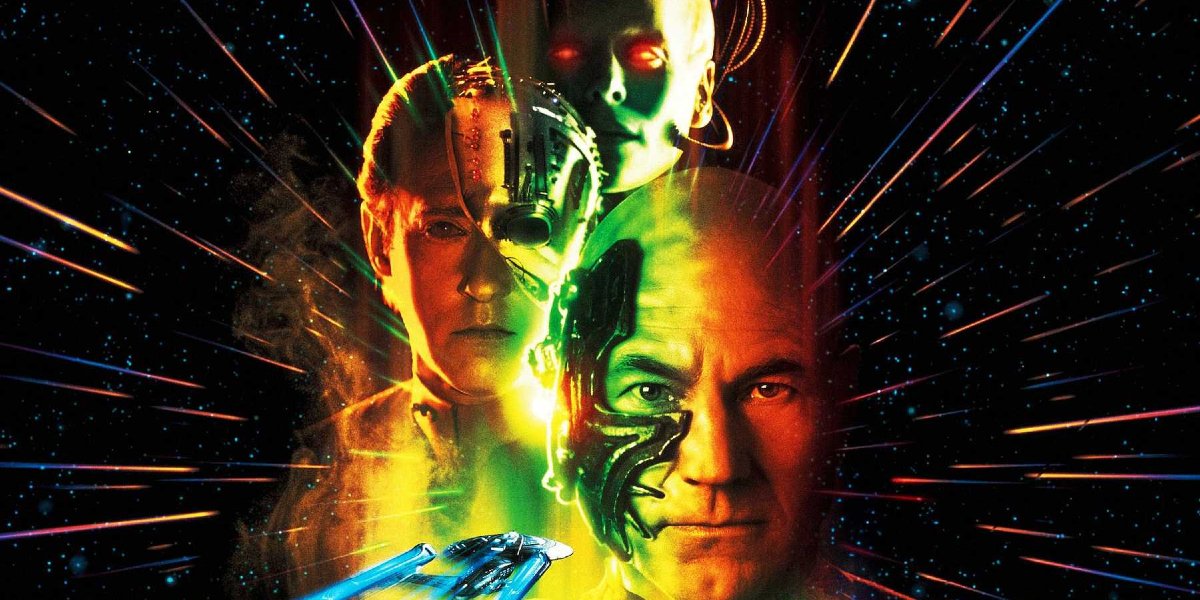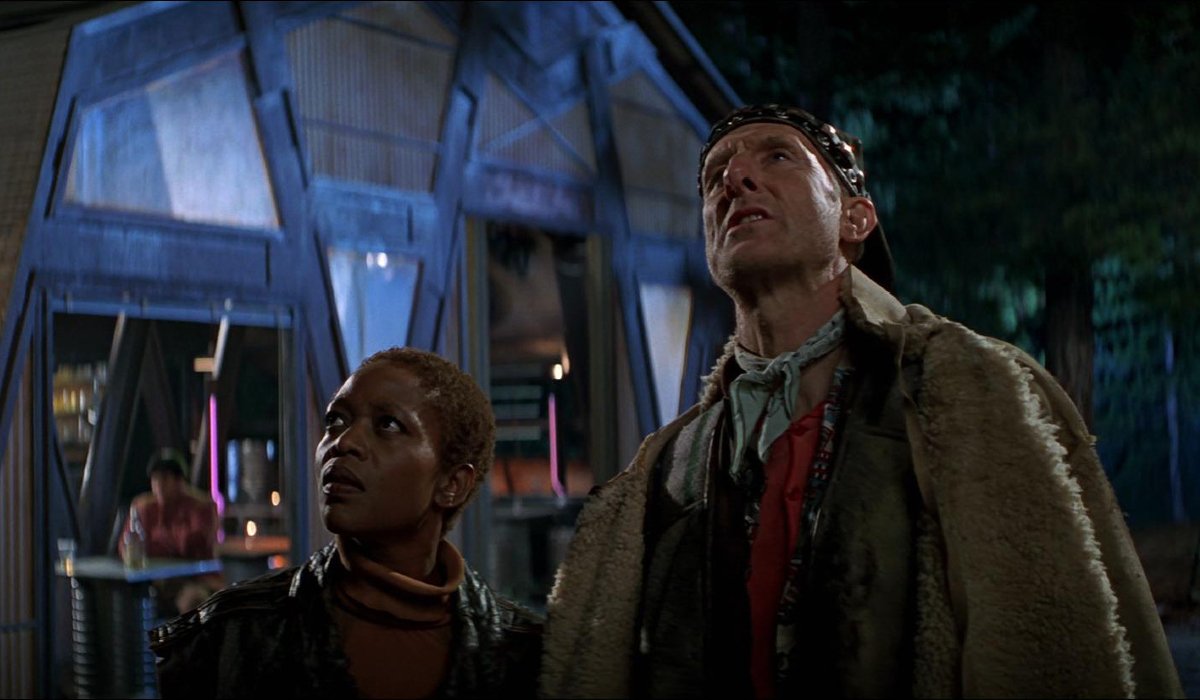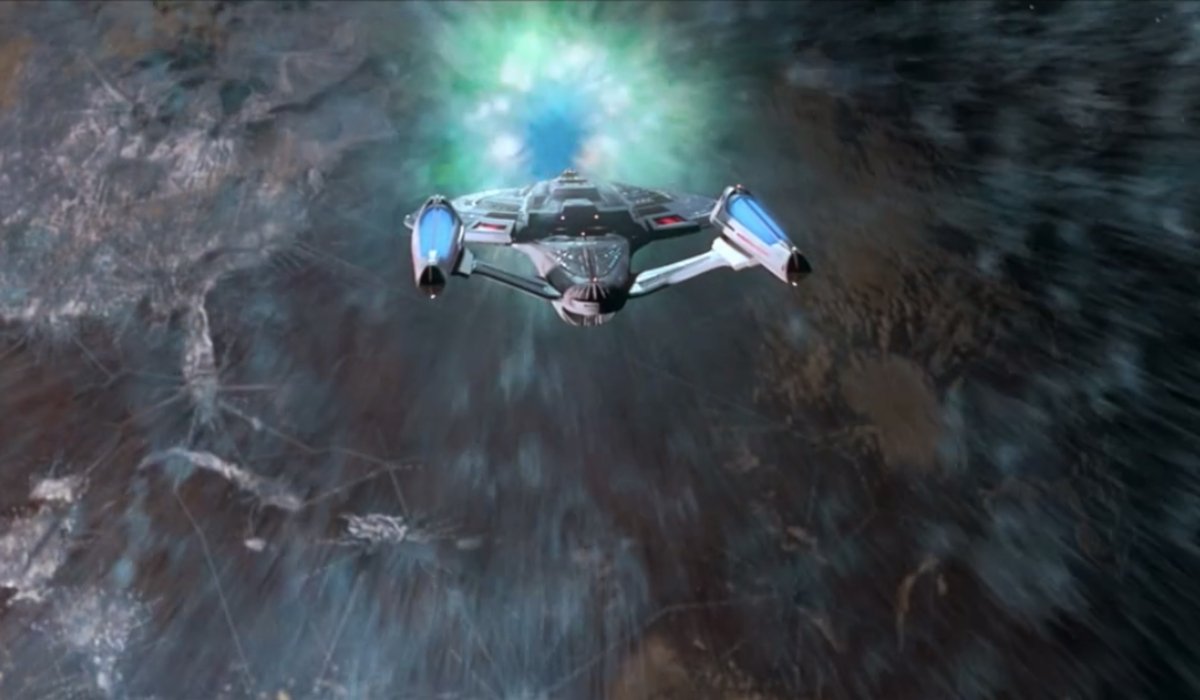How Star Trek: First Contact's Time Travel Works

Space: the final frontier; provided of course, you’re not messing around with time travel. I have to say, after two time loops worth of headaches and logic puzzles, it’s nice to get back to some protein and potatoes time travel. And where better to return to the world of standard temporal chicanery than the Star Trek franchise? In the past we’ve made The Voyage Home, and we’ve seen Generations of Starfleet officers team up to save the universe. But now, we’re about to go back to the moment that made it all possible, as Star Trek: First Contact sees the crew of The Next Generation helping out the first generation of warp speed travelers.
Before we go too far on the timeline, we here at the CinemaBlend labs would like to remind you that you can read several of the other time travel dissections we’ve been running in recent history. Taking our readers here and there in the then and now is one of the most exciting things I’ve been able to do for my employers, and the more twisty the timeline, the more interesting the discussion is. With that polite reminder out of the way, let’s rock and roll and make Star Trek: First Contact our latest temporal case study for the archives.

The Time Travel in Star Trek: First Contact
While the heroes of Star Trek past have been the ones to initiate the usage of time travel, Star Trek: First Contact saw the villains starting this round of temporal combat. After a huge battle with the Borg above 24th century Earth, one of the most iconic villains in the history of the franchise plays the time travel card, in a desperate bid for dominance. And all it took was some old fashioned particle driven science to bring all involved back in time.
Who's Time Traveling
In the corner of evil, we have several renegade Borg who have beamed on to the Enterprise-E, just as their Borg Cube is destroyed by Starfleet’s forces. One of their numbers happens to be the Borg Queen (Alice Krige), who plans to assimilate the Enterprise, and eventually the Earth. But standing up to the forces of evil is the crew of that iconic Starfleet vessel: Captain Jean-Luc Picard (Patrick Stewart), Commander William Riker (Jonathan Frakes,) Lieutenant Commander Data (Brent Spiner), Lieutenant Commander Geordi La Forge (LeVar Burton), Lieutenant Commander Worf (Michael Dorn), Dr. Beverly Crusher (Gates McFadden), and Counselor Deanna Troi (Marina Sirtis).
From When To When
Star Trek: First Contact starts off in the 24th century that the Enterprise-E crew calls “the present.” But thanks to a Borg Sphere released by the main cube that was trying to attack Earth, a temporal rift is opened to transport the Borg Sphere, and the Enterprise-E, back to April 4, 2063. Which just so happens to be the day before the biggest event in Star Trek’s future history.
Your Daily Blend of Entertainment News
The Purpose Of Their Trip
On April 5, 2063, Zephram Cochrane (James Cromwell) makes human history by piloting his ship, “The Phoenix,” into outer space. Making the first warp speed trip of anyone on planet Earth, a nearby Vulcan scout ship notices Cochrane’s craft, and initiates first contact with humanity, which ultimately helps lead to the formation of Starfleet and United Federation of Planets. The Borg wants to stop this from ever happening, while Captain Picard and the crew of the Enterprise-E are trying to make sure history occurs as intended.

How Time Travel Happens In Star Trek: First Contact
In the grand tradition of Star Trek time travel, the method behind the madness in Star Trek: First Contact is the definition of broadly defined. The big temporal Macguffin this time out is “chronometric particles,” and that’s about all of the explanation you’ll get out of anyone in this chrono caper. Through the usage of those particles, the Borg Sphere is able to manipulate a window through time, allowing the probe to move several hundred years back in time. It also happens to be a totally alien phenomenon to the Enterprise-E crew, which makes their trip back in time quite a bit of a fluke; though one not unlike Doctor Emmett Brown’s style of time traveling in the Back to the Future saga.
All the Enterprise has to do is follow in the “temporal wake” of the Borg Sphere, and they’re able to jump to the same exact point in time that the enemy craft emerges in the past. Though getting back to their own home in the time stream is pretty easy as well. Thanks to the their journey through the temporal wake, the Enterprise gathered enough research data for Geordi LaForge to reconfigure the Enterprise-E’s warp field at the end of Star Trek: First Contact. Matching the chronometric readings of the Borg Sphere that created the temporal rift, the ship and her crew warp back to the 24th century.

Can History Be Changed As A Result Of Time Travel In Star Trek: First Contact?
History is indeed changed in Star Trek: First Contact, although it’s only seen in a small glimpse of the hell that the Borg’s version of alternate history provides. Shielded by the temporal wake that makes their journey possible, it’s revealed that the Borg went back centuries in human history in order to do one thing: take over Earth. As the alternate version of Star Trek history is explained, we learn that the entire planet has been assimilated, after the Borg Sphere prevents Zephram Cochrane’s historic warp flight, aiding in the invasion of planet Earth.
Once Captain Picard and his Enterprise crew cross over into 2063, the course of human history is a streamlined experience. Destroying the Borg Sphere that launches an attack on the Montana settlement that Zephram Cochrane and his fellow survivors are living on, the rest of the historically relevant story sees Enterprise crew helping to repair the Phoenix for its significant journey. As history can be changed by rogue actions in Star Trek: First Contact, it can also be restored/preserved by such actions; which is why when it looked like the Enterprise-E was going to be sacrificed to destroy the Borg, Captain Picard sent his crew members “orders to find a quiet corner of North America, and stay out of history’s way,” through his new friend, and assistant to Zephram Cochrane, Lily Sloane (Alfre Woodard.)

What Are The Consequences Of Time Travel In Star Trek: First Contact?
Negatively, the time travel of Star Trek: First Contact was used to change the course of human history; and it almost worked. Zephram Cochrane, dejected and not feeling up to the task of being this mythic savior various Starfleet officers remember from their text books, the first human warp speed flight never takes place. But through the perseverance, inspiration, and assistance of Lieutenant Riker and Lieutenant Commander LaForge, Cochrane takes one magic carpet ride he’ll never forget so long as he lives. First Contact happens as it’s supposed to, and the previously selfish man starts down the path of the visionary that he was always meant to be.
Meanwhile, Captain Picard is forced to confront his PTSD related to his previous assimilation, as his hatred for the Borg almost strands the Enterprise crew members in the past. Learning to push past those feelings, and act in the best interest of the crew, Picard saves Lieutenant Commander Data from the clutches of the seductive Borg Queen. Which is good, because if the Captain hadn’t gone back to save his trusted officer, he may not have missed when firing those torpedoes meant to blow the Phoenix out of the stars.

Assimilate This!
Would you believe we’re almost finished running through the entire Star Trek run of cinematic time travel? It’s been a few short months since we started this task, but that hasn’t kept us from revisiting Starfleet’s finest on a pretty frequent basis. All that stands between us and completion is, what’s possibly, the most detailed and complicated temporal voyage in series history: the 2009 reboot directed by J.J. Abrams! We’re not jumping into that point in time just yet though, as we like to pace ourselves with the Trek around here. Fans cannot live on Roddenberry creations alone, and we’ve got something even more exciting planned for our next outing. Patrick Stewart fans, you’ll be especially pleased, as we’re about to dive into the world of Marvel Comics for the first time.
X-Men: Days of Future Past is our next excursion into the timestream, so if you’ll excuse me, I have to get some things squared away before that happens. Considering the unique brand of time travel that film has in store, this isn’t an adventure one enters into lightly. Oh, and before you leave the lab, don’t forget to use the comments section as your go-to suggestion box to tell us which time travel enhanced movies you’d like to see tackled next. Until next time, fellow travelers!

Mike Reyes is the Senior Movie Contributor at CinemaBlend, though that title’s more of a guideline really. Passionate about entertainment since grade school, the movies have always held a special place in his life, which explains his current occupation. Mike graduated from Drew University with a Bachelor’s Degree in Political Science, but swore off of running for public office a long time ago. Mike's expertise ranges from James Bond to everything Alita, making for a brilliantly eclectic resume. He fights for the user.

